AMD announces Radeon RX 5700 XT for $449 and RX 5700 for $379
Full specs and features look good, but the price is far more than we wanted.
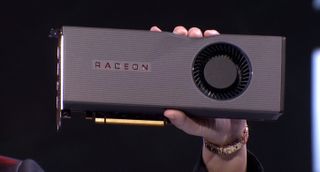
After months of speculation, AMD has finally revealed the specs, pricing, and its own internal performance numbers for the Radeon RX 5700 XT and RX 5700 graphics cards. Let's start at the top, with performance.
AMD showed us benchmarks of the RX 5700 XT and RX 5700 taking on Nvidia's RTX 2070 and RTX 2060, respectively. There are the usual disclaimers that these numbers have not been independently confirmed, but I suspect they're fairly accurate. They're also more likely to be skewed toward games that favor AMD, however, so by no means do they represent all games.
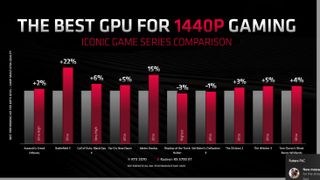
The Radeon RX 5700 XT will cost $449 and is a 225W TDP part using AMD's new RDNA architecture, and fabricated on TSMC's 7nm process technology. In AMD's benchmarks, there are certain games where AMD comes out well ahead of Nvidia, like Battlefield 5 and Metro Exodus. However, it does need to be said that both games can support DXR (DirectX Raytracing), which wasn't enabled since AMD's Navi architecture does not support the DXR API.
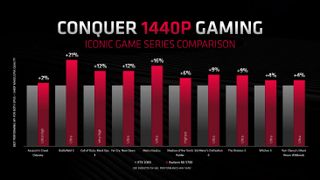
For the RX 5700 and RTX 2060, AMD does even better in performance—it wins in every game tested. That's perhaps not too surprising, since AMD has 8GB GDDR6 and the 5700 only trims off 10 percent of the cores of the 5700 XT, whereas the 2060 has 17 percent fewer cores and 2GB less memory. Which brings me to the specs:
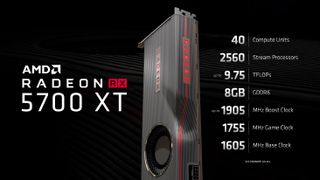
AMD's new Navi GPUs are a significant reworking of its graphics architecture. AMD will tell you it's a completely new architecture, though in briefings it feels more like a rearrangement and enhancements of GCN than something completely new. There are definitely changes, and AMD claims up to 25 percent better performance per CU (at the same clock) relative to the previous generation. Combined with power efficiency improvements, that's 50 percent better performance per watt. What that means is the RX 5700 XT at 225W can actually outperform the RX Vega 64 in games by a small margin.
By the numbers, the Navi (Navi 10) GPU in the RX 5700 XT has 40 CUs and 2,560 stream processor cores, 8GB of GDDR6 clocked at 14GT/s (448GB/s of bandwidth), a base clock of 1605MHz, with a boost clock of 1905MHz and a Game Clock of 1755MHz. The game clock is a new spec for AMD, and it represents a "conservative" lower limit of the clockspeeds you should see during games. In fact, AMD says most of the time the GPU will run closer to the boost clock than the game clock, but the only guarantee is the base clock.
The 9.75 TFLOPS result comes from the boost clock, which would then be an upper limit on AMD's performance. Again, however, TFLOPS isn't everything. With 25 percent better performance per core thanks to architectural improvements, the RX 5700 XT should perform more like a 12 TFLOPS GCN part—which is basically where the Vega 64 sits. On the other hand, Nvidia still appears to make better use of its theoretical TFLOPS, so even though the 2070 is a 7464 TFLOPS part it's only a bit slower than AMD's chip. And Nvidia apparently has upcoming "Super" versions of some of its RTX GPUs that will have higher clockspeeds, which could put Nvidia back in the lead.
The biggest gaming news, reviews and hardware deals
Keep up to date with the most important stories and the best deals, as picked by the PC Gamer team.
But ultimately it comes down to performance and pricing. And here's where AMD comes up short. $449 is technically less than Nvidia's RTX 2070, but that card is nearly 9 months old and is now routinely selling for $450. That means the same price, without ray tracing and Tensor cores, with a higher power draw. Hmm.
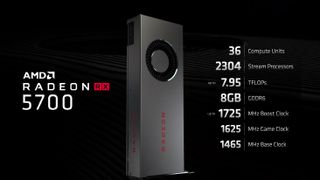
Moving on to the Radeon RX 5700 specs, the main change is that four CUs are disabled. That reduces the core count to 2304, and clockspeeds are also lower across the board. It keeps the full 8GB GDDR6, however, still clocked at 14GT/s. Performance is now 7.95 TFLOPS (boost), so with the lower clockspeeds it's nearly 20 percent slower than its big brother. But TDP is also 175W instead of 225W, which is only a tad higher than the RTX 2060's 160W TDP.
The Radeon RX 5700 also drops the price to $379, and with better performance than the RTX 2060, the value proposition at first looks decent. Nvidia will tell you about ray tracing and DLSS, but the 2060 isn't really a great product for ray tracing, and we're still waiting for a real killer app in that area. Battlefield 5, Metro Exodus, Shadow of the Tomb Raider, Justice, and the Quake 2 RTX version are nice, but framerates still take a big hit for only moderately improved visuals in most cases. Quake 2 RTX is the biggest change in visuals, but that's a game from 1997. It ought to look very different with a dramatically changed lighting and reflections engine.
The problem is that the RTX 2060 is officially a $349 part, with many cards selling for that price. In fact, the cheapest RTX 2060 cards now start at $320. Again, Nvidia has more features (even if they're questionable), lower power use, and a better price. And it's doing it on an older process technology.
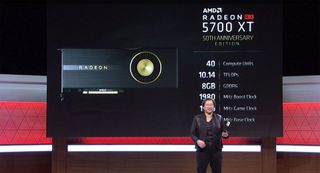
For the AMD faithful, AMD has one more RX 5700 XT card, the 50th anniversary model. It's got gold accents and slightly higher clockspeeds, for a price of $499. It will be available in limited quantities, alongside the rest of the RX 5700 lineup.
There's a lot more to say about Navi and the Radeon 5700, which I'll dig into more with our Radeon 5700 Everything We Know. There's a lot to cover in the architecture and specs, but it still comes down to performance, features, and pricing. There were supposedly leaks many months ago, but it's safe to say now that those were all completely bunk. Not only did the leaks have the wrong name, but the specs and pricing are way off. If you were hoping for a $249 RTX 2060 competitor, or even an RTX 2070 competitor, that's definitely not happening.
Radeon RX 5700 and the RDNA architecture are a good step forward. They're also the first consumer PCIe 4.0 graphics cards. But if you're looking at pure efficiency, Navi appears to be roughly on par with Nvidia's Pascal architecture, which is three years old and manufactured on 16nm. The GTX 1080 is probably only a bit slower than the RX 5700 XT, based on these initial performance figures from AMD, and likewise the GTX 1070 is only moderately slower than the RX 5700. But those are 180W and 150W parts.
Compare Navi with Nvidia's current Turing architecture and things get even messier. The RTX 2060 and 2070 are six months and ten months old, respectively, built on 12nm tech, and still have lower TDPs of 160W and 175W. Nvidia wins on features and power, with pricing mostly a wash on the 2070 and slightly favoring the 2060. Not that power is the driving factor in all things, but I had hoped for a bit more, with all the talk of RDNA being a new "from the ground up" architecture.
Another problem the Radeon RX 5700 cards face is the same one that Nvidia has had with its RTX 20-series GPUs: convincing gamers that they actually need to upgrade. If you're running a GTX 1070 or above or an RX Vega card, you'd mostly be looking at a lateral move. And if you're running a slower GPU, why didn't you upgrade to a 2060 or 2070 already for roughly the same price, or a 1070 or 1080 a couple of years back? If these were midrange priced GPUs delivering this level of performance, that would be great, but instead they're high-end offerings.
Like the Ryzen 3000 CPUs, the Radeon RX 5700 XT and RX 5700 are set to launch on July 7, 2019. We'll have full reviews of the cards on or before the launch date. Stay tuned.
Jarred's love of computers dates back to the dark ages when his dad brought home a DOS 2.3 PC and he left his C-64 behind. He eventually built his first custom PC in 1990 with a 286 12MHz, only to discover it was already woefully outdated when Wing Commander was released a few months later. He holds a BS in Computer Science from Brigham Young University and has been working as a tech journalist since 2004, writing for AnandTech, Maximum PC, and PC Gamer. From the first S3 Virge '3D decelerators' to today's GPUs, Jarred keeps up with all the latest graphics trends and is the one to ask about game performance.
Most Popular





